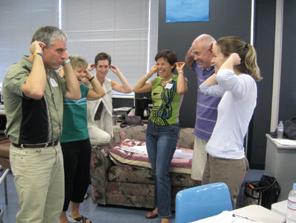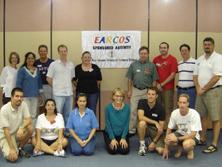
3 minute read
Weekend Workshop with Nancy Doda – Teaching the Best Practice Way: Classroom of
Weekend Workshop with Nancy Doda Teaching the Best Practice Way: Classrooms of Success for All September 13-14, 2008
On September 13th and 14th the American School in Japan hosted 40 teachers from around the region at Teaching the Best Practice Way: Classrooms of Success for All, a workshop focused on teaching and learning in the middle years. The middle school focus attracted a diverse group of attendees from Japan, Korea, Thailand, Singapore, and China.
Our presenter, Nancy Doda, not only facilitated our learning, she inspired us to examine our practice so that every student we teach can reach his or her full potential. Nancy is an author, professor, and John H. Lounsbury Award winner and is considered to be one of the top middle level experts in the US. She has worked with hundreds of schools and districts all over the world. She has presented at the National Middle School Association Annual Conference for a number of years. Nancy is currently a full-time professional development facilitator, keynote speaker, workshop leader, and author.
This two-day workshop was designed to help educators better understand and more effectively implement effective classroom instruction in the middle grades. Drawing on an emerging synthe sis in the field regarding what constitutes “best practice,” Nancy engaged participants in model practices with opportunities to examine the underlying theory and related research for each method or approach studied. As Nancy modeled strategies, we became a community of learners dedicated to working together to improve our practice. As one participant said, “I want to inspire my students to ‘want to learn’ in the same way [Nancy] encouraged me to ‘want to improve’ my teaching.”
Over the two days, we became more knowledgeable about best practice strategies of differentiation as well as the critical role of multiple intelligences and recent brain research. Nancy Who knew rolling our ear lobes could affect our learning? Participants learn kinesthetically about the latest brain research.
made sure that we had the opportunity to experience “teaching the best practice way” from the perspective of students.
The questions we sought to answer were:
* What kind of classroom culture supports student engagement, investment, and learning? * How can teachers develop such a supportive classroom culture? * What instructional principles define “best practice” teaching? * What methods and approaches are exemplars of “best practice” teaching? * What approaches are particularly effective with a varied and diverse population of learners?
As always at EARCOS weekend workshops, the participants particularly valued the dialogue with colleagues and the network ing with like-minded teachers and administrators from other schools. Several commented that it was the best workshop they had ever attended.
What Makes a Mathematical Task Worthwhile? Learning to Think Deeply at International School Bangkok
“Who wants to spend a weekend in Bangkok? raise your hand! Who wants to spend a weekend in Bangkok doing math? Wait a minute, where are you going?” You may be wondering who chose math and why,—well, read on.
ISB hosted an EARCOS sponsored workshop led by Rebecca Bogert on September 27 and 28. Rebecca is a former teacher and principal who now, after extensive work in reform math and sci ence movements, leads professional development programs to support these paradigm shifts. The workshop topic that caught our attention? “What Makes a Mathematical Task Worthwhile: Deepening and Challenging Student Understanding.”
First, we must have agreed that student understanding needs to be “deepened and challenged” or we wouldn’t have been there. Our first question was, “What criteria must a mathematical task meet to be considered deep and challenging?” Rebecca led us

through a series of activities throughout both days, which pushed our own understanding of mathematics from a personal perspec tive. For example, who would have thought that asking 15 adults to model 15% on a 6 x 10 grid would have generated so much discourse and so many proud presenters of their unique models?










